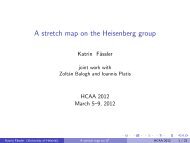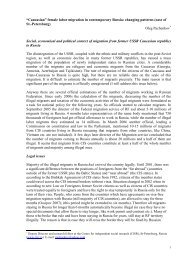THORIUM AS AN ENERGY SOURCE - Opportunities for Norway ...
THORIUM AS AN ENERGY SOURCE - Opportunities for Norway ...
THORIUM AS AN ENERGY SOURCE - Opportunities for Norway ...
Create successful ePaper yourself
Turn your PDF publications into a flip-book with our unique Google optimized e-Paper software.
Thorium as an Energy Source - <strong>Opportunities</strong> <strong>for</strong> <strong>Norway</strong><br />
in Telemark (Chapter 3: Thorium Resources in <strong>Norway</strong>). The Fen Complex has been considered as<br />
the most promising resource, with thorium amounting to about 0.1 – 0.4 wt%.<br />
Doses to man and the environment in Fen are attributed to the high Th-232 levels (Table 7.2,<br />
[15]) and the presence of uranium in the rock types rödberg (Th-232 average 3100 Bq/kg, can<br />
reach 5000 Bq/kg, Ra-226 from U-238 can reach 120 Bq/kg) and rauhaugite (Ra-226 up to 300<br />
Bq/kg). The thorium levels in the Nordic rock types typically range from 0.5 to 350 Bq/kg and the<br />
thorium levels measured in the rödberg are the highest ever recorded in Norwegian bedrock [15].<br />
The Ra-226 levels from U-238 in rödberg and rauhaugite are also high, concentrations above 100<br />
Bq/kg are generally only found in black shales and radium-rich granites. The total effective dose<br />
from naturally occurring radiation received by the Norwegian population is currently estimated<br />
to be 2.9 mSv per year, while critical groups in Fen can easily receive more than 10 mSv per year<br />
[15]. Based on a recent investigation, the enhanced levels of thorium and uranium and their<br />
daughters in the Fen Complex contributed to the highest outdoor and indoor gamma exposures to<br />
man ever reported in <strong>Norway</strong>, and are among the highest in Europe. Thorium and associated<br />
radionuclides and metals are expected to represent an environmental problem in the Fen area,<br />
due to the presence of thorium bearing minerals in the rock types rödberg and rauhaugite. It is<br />
expected that the radionuclides can mobilise from surface minerals especially during flooding and<br />
acid rain episodes. Mobilisation processes may produce bioavailable radionuclide/metal species,<br />
which may accumulate in biota and contribute to internal exposure. The external and internal<br />
radionuclide exposures can induce biological responses of relevance <strong>for</strong> reproduction and growth,<br />
especially if synergism with associated metals takes place. However, doses to man and the<br />
environment from natural radiation are in principle not regulated. When man-made activities<br />
such as mining and milling are introduced, a revised version of the Radiation Protection Act will<br />
most probably be developed.<br />
Table 7.2: Activity Concentrations of Th-232, Ra-226 (from U-238) and the Potassium Isotope K-40<br />
in Rock Samples from the Fen Central Complex and Adjacent Areas.<br />
Rock Type<br />
Number of<br />
Samples<br />
Th-232<br />
(Bq/kg) a)<br />
Ra-226<br />
(Bq/kg) b)<br />
K-40<br />
(Bq/kg) c)<br />
Mean Range Mean Range Mean Range<br />
Rödberg 9 3100 (390 - 5900) 70 (20 - 110) 310 (60 - 430)<br />
Rauhaugite 9 600 (290 - 930) 120 (40 - 300) 60 (40 - 70)<br />
Sövite 9 80 (20 - 190) 20 (10 - 60) 30 (20 - 40)<br />
Fenite 8 130 (20 - 200) 50 (40 - 80) 1060 (750 - 1500)<br />
Precambrian<br />
Gneiss d)<br />
3<br />
66 (68 - 63) 45 (43 - 46) -<br />
a) 4 Bq/kg Th-232 is equivalent to 1 ppm Th, at radioactive equilibrium.<br />
b) 12.3 Bq/kg Ra-226 is equivalent to 1 ppm U, at radioactive equilibrium.<br />
c) 310 Bq/kg K-40 is equivalent to 1 % K.<br />
d) Outside the Fen Central Complex.<br />
7.3 Doses Associated with the Back end of the Thorium Cycle<br />
Radiation associated with the back end of the thorium cycle and associated safety aspects are<br />
discussed in Chapter 6. Doses to man and the environment will vary according to the fuel<br />
composition, reactor system and operations. There are advantages in using thorium in thermal<br />
reactors in a once-through mode, in particular if U-233 or U-235 (HEU) is used as topping<br />
material. If the burnup of thorium fuel can be extended, the waste is less radiotoxic up to 20 000<br />
82

















